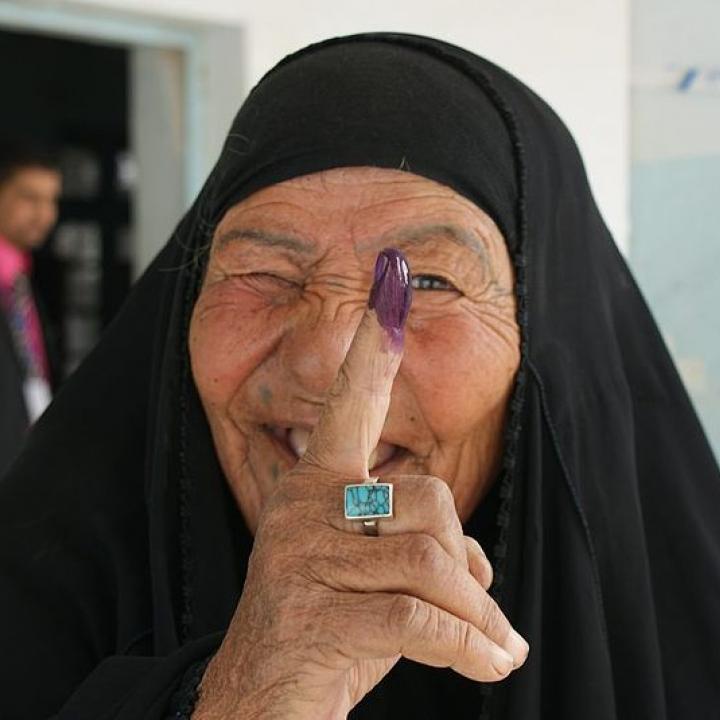
- Policy Analysis
- Fikra Forum
Opinion Survey Insights into the 2018 Iraqi Election

The results of the May 2018 Iraqi elections caught many by surprise, especially in the polling field. A series of public opinion surveys conducted between March and May predicted that the Nasr Coalition, led by Prime Minister Haider al-Abadi, would win the highest number of seats in the Iraqi Parliament. Instead, Abadi’s list was surpassed by the Sairoon and Fatah Alliances, which won the first and second largest number of parliamentary seats, respectively.
While fraud has likely impacted election results, this outcome cannot be explained in terms of cheating alone. Research I began conducting two days after the election has indicated that election outcomes were shaped by an interplay of four different factors: low voter turnout, desire for change, the contenders’ campaign strategies, and Shiite clerics’ stance on candidates.
Since the fall of Saddam Hussein’s regime, voter turnout in Iraq has shrunk with each passing election: in 2005, eighty percent of eligible Iraqi voters went to the polls. That figure was reduced to around sixty percent during the 2010 and 2014 elections, and plummeted to 44.5 percent in 2018. While Iraq’s low voter turnout has been much discussed, the impact of this trend on active voters must also be emphasized. Because of the low participation rate in the most recent election, swing voters who did go to the polls had considerable influence over the results, more so than in previous elections. These circumstances proved beneficial for the victorious Sairoon Alliance, which obtained thirty percent of swing votes. On the other hand, the Nasr Coalition only received fifteen percent of total swing votes.
According to a nationwide survey held after the results were already in, fifty percent of the individuals who voted for the Sairoon Alliance only made up their minds about how to cast their ballot in the week immediately preceding the election. As such, it would be reasonable to conclude that at least half of Sairoon’s voters are not staunch supporters of the alliance; as a matter of fact, many of them actually seem to be secular nationalists.
But what guided these voters’ behavior? Why, in other words, did so many swing voters favor the Sairoon Alliance over the incumbent’s bloc? It appears that the answer to these questions lies in the campaign strategies adopted by the different political coalitions in the time leading up to the election.
The Nasr Coalition built its campaign around Abadi’s performance as prime minister and his image as a statesman. However, while Abadi had indeed accomplished a lot during his time in office, Iraqis tend to be suspicious toward the state and its agents. Moreover, during this past election, corruption was a deciding factor for many Iraqi voters. This preoccupation with corruption turned out to be damaging for Abadi, not only because of his status as a political insider, but also because voters believed that, as head of the government, he did not do enough to alleviate the problem. In this context, Abadi’s efforts to address the issue during the campaign appear to have been too little too late. Thus, as a campaign strategy, emphasizing Abadi’s experience may not have only been ineffective, but also harmful.
Whereas the Nasr Coalition tried to appeal to voters by focusing on the past, specifically focusing on their victory over ISIS, the Sairoon Alliance, headed by Shia cleric Muqtada al-Sadr, campaigned on the idea of change. Joining forces with the Iraqi Communist Party and civil society activists, the list was able to attract secular voters who nonetheless espouse Islamist values. Of course, the Nasr Coalition’s misguided campaign has probably also contributed to the success of the Sairoon Alliance.
Although the emphasis on change may have appealed to many secular Iraqis, they were not the only target audience for the Sairoon Alliance’s campaign messages, nor were they alone responsible for the list’s victory. Prior to the election, the highest ranks among the clergy in Najaf warned the Shiite public against granting incumbents second chances. This stance was a blow for political veterans like Abadi and his predecessor, Nouri al-Malik, who was also a candidate in this year’s election. By contrast, Sadr is a highly powerful figure in Iraqi politics, he has never held office.
For dedicated Shias, following the instructions of the clergy is a matter of faith. Indeed, it appears that the clergy’s message has had an impact on voters’ behavior. For example, based on survey results, it appears that forty-three percent of those who voted for the Sairoon Alliance and thirty-two percent of those who voted for the Fatah Alliance chose to do so because these lists’ candidates had not yet been tested as government politicians.
Iraq’s most recent election represents a departure from the norm in more than one respect. Those who voted clearly had an appetite for change and were willing to make bold, sometimes unexpected choices to bring such change about. During the election, many Sunnis crossed sectarian lines, giving their votes to Shia candidates like Abadi, who received thirty-six percent of his votes from Iraqi-Sunnis, and Hadi al-Amiri of the Fatah Alliance, who received fifteen percent of his votes from the same group. There are also signs that Iraqi Shias are starting to move away from their old voting patterns, which may reflect a more permanent shift in Iraqi electoral politics towards prioritizing demands for change over past party affiliation.

